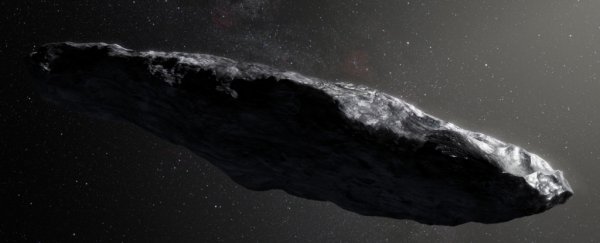When 'Oumuamua first came to the notice of astronomers, zooming into the Solar System from very, very far away, it was assumed that the object was a comet.
On closer examination, though, it looked more like an asteroid after all, and its classification was duly changed. Now, however, an international team of scientists has conducted more research - and there's something a bit comet-y about it after all.
The difference between comets and asteroids is what they're made of. Comets are made of ice, and dust, and a bit of rock. The comets in our Solar System formed far away from the Sun, where its heat couldn't melt their ice.
When a comet's orbit approaches the Sun, the heat vapourises some of the ice, which also releases dust and rock particles embedded in the ice, creating the tails that comets are famous for.
An asteroid, on the other hand, is made of rock, dust, and metal. They are able to form a bit closer to the Sun than comets, and they don't shrink if they get even closer.
'Oumuamua showed none of the characteristics associated with comets. It was reddish in colour, and showed no signs of dust around it - indicating that it was composed of dense rock and metal, reddened by cosmic radiation, and containing no water or ice.
Led by astronomer Alan Fitzsimmons of Queen's University Belfast, the team from the US, the UK, Canada, Taiwan and Chile used spectroscopy to analyse the way 'Oumuamua reflects sunlight - its albedo - and found it similar to icy minor planets in the outer Solar System with a dry crust wrapped around an icy core.
This mantle could have protected the core when 'Oumuamua sped past the Sun at a distance of just 37 million kilometres (23 million miles) on 9 September.
"We have discovered that the surface of `Oumuamua is similar to small solar system bodies that are covered in carbon-rich ices, whose structure is modified by exposure to cosmic rays," Fitzsimmons said.
"We have also found that a half-metre thick coating of organic-rich material could have protected a water-ice-rich comet-like interior from vapourising when the object was heated by the sun, even though it was heated to over 300 degrees centigrade."
As seen in very old comets, as cosmic radiation evaporates the carbon-rich ice in the surface layers of the object, the material left behind is an organic residue that has a reddish hue - and this is what is observed in 'Oumuamua.
Because it's so similar to outer Solar System objects, the team believes 'Oumuamua constitutes evidence that other solar systems contain objects similar to our own.
"We've discovered that this is a planetesimal with a well-baked crust that looks a lot like the tiniest worlds in the outer regions of our solar system, has a greyish/red surface and is highly elongated, probably about the size and shape of the Gherkin skyscraper in London," said Queen's University Belfast astronomer Michelle Bannister, who has been researching icy outer Solar System objects.
"It's fascinating that the first interstellar object discovered looks so much like a tiny world from our own home system. This suggests that the way our planets and asteroids formed has a lot of kinship to the systems around other stars."
Research into our Solar System's first known external visitor is ongoing.
Meanwhile, the team's research has been published in the journal Nature Astronomy.
